Radial Growth Response of Siberian Pines to Climate Warming in the Sayan Mountains, Southern Siberia, Russian Federation
Abstract
1. Introduction
2. Materials and Methods
2.1. Study Area
2.2. Tree Ring Data
2.3. Climatic Data
2.4. Quantify Tree Radial-Growth Rate
2.5. Radial Growth Climate Analyses
3. Results
3.1. Identify Positive and Negative Growth Rate Anomalies
3.2. Radial Growth–Climate Relationships
3.3. Growth Rate-Temperature Relationships
4. Discussion
5. Conclusions
Author Contributions
Funding
Data Availability Statement
Conflicts of Interest
Appendix A

References
- AR5 Climate Change 2013: The Physical Science Basis—IPCC. Available online: https://www.ipcc.ch/report/ar5/wg1/ (accessed on 6 November 2022).
- Canadell, J.G.; Raupach, M.R. Managing Forests for Climate Change Mitigation. Science 2008, 320, 1456–1457. [Google Scholar] [CrossRef] [PubMed]
- Special Report on Climate Change and Land—IPCC Site. Available online: https://www.ipcc.ch/srccl/ (accessed on 6 November 2022).
- Harris, N.L.; Gibbs, D.A.; Baccini, A.; Birdsey, R.A.; de Bruin, S.; Farina, M.; Fatoyinbo, L.; Hansen, M.C.; Herold, M.; Houghton, R.A.; et al. Global Maps of Twenty-First Century Forest Carbon Fluxes. Nat. Clim. Chang. 2021, 11, 234–240. [Google Scholar] [CrossRef]
- Cuny, H.E.; Rathgeber, C.B.K.; Frank, D.; Fonti, P.; Mäkinens, H.; Prislan, P.; Rossi, S.; del Castillo, E.M.; Campelo, F.; Vavrčík, H.; et al. Woody Biomass Production Lags Stem-Girth Increase by over One Month in Coniferous Forests. Nature Plants 2015, 1, 15160. [Google Scholar] [CrossRef] [PubMed]
- Pan, Y.; Birdsey, R.A.; Fang, J.; Houghton, R.; Kauppi, P.E.; Kurz, W.A.; Phillips, O.L.; Shvidenko, A.; Lewis, S.L.; Canadell, J.G.; et al. A Large and Persistent Carbon Sink in the World’s Forests. Science 2011, 333, 988–993. [Google Scholar] [CrossRef]
- Huang, J.-G.; Ma, Q.; Rossi, S.; Biondi, F.; Deslauriers, A.; Fonti, P.; Liang, E.; Mäkinen, H.; Oberhuber, W.; Rathgeber, C.B.K.; et al. Photoperiod and Temperature as Dominant Environmental Drivers Triggering Secondary Growth Resumption in Northern Hemisphere Conifers. Proc. Natl. Acad. Sci. USA 2020, 117, 20645–20652. [Google Scholar] [CrossRef]
- Jacoby, G.C.; D’Arrigo, R.D. Tree Rings, Carbon Dioxide, and Climatic Change. Proc. Natl. Acad. Sci. USA 1997, 94, 8350–8353. [Google Scholar] [CrossRef]
- Cohen, W.B.; Yang, Z.; Stehman, S.V.; Schroeder, T.A.; Bell, D.M.; Masek, J.G.; Huang, C.; Meigs, G.W. Forest Disturbance across the Conterminous United States from 1985–2012: The Emerging Dominance of Forest Decline. For. Ecol. Manag. 2016, 360, 242–252. [Google Scholar] [CrossRef]
- Chen, L.; Huang, J.-G.; Alam, S.A.; Zhai, L.; Dawson, A.; Stadt, K.J.; Comeau, P.G. Drought Causes Reduced Growth of Trembling Aspen in Western Canada. Glob. Chang. Biol. 2017, 23, 2887–2902. [Google Scholar] [CrossRef]
- Phillips, O.L.; Aragão, L.E.O.C.; Lewis, S.L.; Fisher, J.B.; Lloyd, J.; López-González, G.; Malhi, Y.; Monteagudo, A.; Peacock, J.; Quesada, C.A.; et al. Drought Sensitivity of the Amazon Rainforest. Science 2009, 323, 1344–1347. [Google Scholar] [CrossRef]
- Beck, P.S.A.; Juday, G.P.; Alix, C.; Barber, V.A.; Winslow, S.E.; Sousa, E.E.; Heiser, P.; Herriges, J.D.; Goetz, S.J. Changes in Forest Productivity across Alaska Consistent with Biome Shift: Changes in Forest Productivity across Alaska. Ecology Lett. 2011, 14, 373–379. [Google Scholar] [CrossRef]
- Nitschke, C.R.; Nichols, S.; Allen, K.; Dobbs, C.; Livesley, S.J.; Baker, P.J.; Lynch, Y. The Influence of Climate and Drought on Urban Tree Growth in Southeast Australia and the Implications for Future Growth under Climate Change. Landsc. Urban Plan. 2017, 167, 275–287. [Google Scholar] [CrossRef]
- Goldblum, D.; Rigg, L.S. Tree Growth Response to Climate Change at the Deciduous–Boreal Forest Ecotone, Ontario, Canada. Can. J. For. Res. 2005, 35, 11. [Google Scholar] [CrossRef]
- Huang, J.-G.; Bergeron, Y.; Berninger, F.; Zhai, L.; Tardif, J.C.; Denneler, B. Impact of Future Climate on Radial Growth of Four Major Boreal Tree Species in the Eastern Canadian Boreal Forest. PLoS ONE 2013, 8, e56758. [Google Scholar] [CrossRef] [PubMed]
- Sidorova, O.V.; Vaganov, E.A.; Naurzbaev, M.M.; Shishov, V.V.; Hughes, M.K. Regional Features of the Radial Growth of Larch in North Central Siberia According to Millennial Tree-Ring Chronologies. Russ. J. Ecol. 2007, 38, 90–93. [Google Scholar] [CrossRef]
- Dixon, R.K.; Brown, S.; Houghton, R.A.; Solomon, A.M.; Trexler, M.C.; Wisniewski, J. Carbon Pools and Flux of Global Forest Ecosystems. Sci. New Ser. 1994, 263, 185–190. [Google Scholar] [CrossRef]
- Shepashenko, D.; Shvidenko, A.; Nilsson, S. Phytomass (Live Biomass) and Carbon of Siberian Forests. Biomass Bioenergy 1998, 14, 21–31. [Google Scholar] [CrossRef]
- Kharlamova, N.; Sukhova, M.; Chlachula, J. Present Climate Development in Southern Siberia: A 55-Year Weather Observations Record. IOP Conf. Ser. Earth Environ. Sci. 2019, 395, 012027. [Google Scholar] [CrossRef]
- Kharuk, V.I.; Im, S.T.; Petrov, I.A. Warming Hiatus and Evergreen Conifers in Altay-Sayan Region, Siberia. J. Mt. Sci. 2018, 15, 2579–2589. [Google Scholar] [CrossRef]
- Zhirnova, D.F.; Belokopytova, L.V.; Krutovsky, K.V.; Kholdaenko, Y.A.; Babushkina, E.A.; Vaganov, E.A. Spatial-Coherent Dynamics and Climatic Signals in the Radial Growth of Siberian Stone Pine (Pinus Sibirica Du Tour) in Subalpine Stands along the Western Sayan Mountains. Forests 2022, 13, 1994. [Google Scholar] [CrossRef]
- Petrov, I.A.; Kharuk, V.I.; Dvinskaya, M.L.; Im, S.T. Reaction of Coniferous Trees in the Kuznetsk Alatau Alpine Forest-Tundra Ecotone to Climate Change. Contemp. Probl. Ecol. 2015, 8, 423–430. [Google Scholar] [CrossRef]
- Nowacki, G.J.; Abrams, M.D. Radial-Growth Averaging Criteria for Reconstructing Disturbance Histories from Presettlement-Origin Oaks. Ecol. Monogr. 1997, 67, 225–249. [Google Scholar] [CrossRef]
- Stan, A.B.; Daniels, L.D. Calibrating the Radial-Growth Averaging Method for Detecting Releases in Old-Growth Forests of Coastal British Columbia, Canada. Dendrochronologia 2010, 28, 135–147. [Google Scholar] [CrossRef]
- Kharuk, V.I.; Ranson, K.J.; Im, S.T.; Dvinskaya, M.L. Response of Pinus Sibirica and Larix Sibirica to Climate Change in Southern Siberian Alpine Forest–Tundra Ecotone. Scand. J. For. Res. 2009, 24, 130–139. [Google Scholar] [CrossRef]
- Myglan, V.S.; Oidupaa, O.C.; Vaganov, E.A. A 2367-Year Tree-Ring Chronology for the Altai–Sayan Region (Mongun-Taiga Mountain Massif). Archaeol. Ethnol. Anthropol. Eurasia 2012, 40, 76–83. [Google Scholar] [CrossRef]
- Daniels, L.D.; Maertens, T.B.; Stan, A.B.; McCloskey, S.P.J.; Cochrane, J.D.; Gray, R.W. Direct and Indirect Impacts of Climate Change on Forests: Three Case Studies from British Columbia. Can. J. Plant Pathol. 2011, 33, 108–116. [Google Scholar] [CrossRef]
- Briffa, K.R.; Osborn, T.J.; Schweingruber, F.H.; Jones, P.D.; Shiyatov, S.G.; Vaganov, E.A. Tree-Ring Width and Density Data around the Northern Hemisphere: Part 1, Local and Regional Climate Signals. Holocene 2002, 12, 737–757. [Google Scholar] [CrossRef]
- Hellmann, L.; Agafonov, L.; Ljungqvist, F.C.; Churakova (Sidorova), O.; Düthorn, E.; Esper, J.; Hülsmann, L.; Kirdyanov, A.V.; Moiseev, P.; Myglan, V.S.; et al. Diverse Growth Trends and Climate Responses across Eurasia’s Boreal Forest. Environ. Res. Lett. 2016, 11, 074021. [Google Scholar] [CrossRef]
- Holmes, R.L. Computer-assisted quality control in tree-ring dating and measurement. Tree-Ring Bull. 1983, 43, 69–78. [Google Scholar]
- Cook, E.R.; Holmes, R.L. Users Manual for Program ARSTAN; Laboratory of Tree-Ring Research, University of Arizona: Tucson, AZ, USA, 1986. [Google Scholar]
- Cook, E.R.; Peters, K. Calculating Unbiased Tree-Ring Indices for the Study of Climatic and Environmental Change. Holocene 1997, 7, 361–370. [Google Scholar] [CrossRef]
- Melvin, T.M.; Briffa, K.R. A “Signal-Free” Approach to Dendroclimatic Standardisation. Dendrochronologia 2008, 26, 71–86. [Google Scholar] [CrossRef]
- Wigley, T.M.L.; Briffa, K.R.; Jones, P.D. On the Average Value of Correlated Time Series with Applications in Dendroclimatology and Hydrometeorology. J. Clim. Appl. Meteorol. 1984, 23, 201–213. [Google Scholar] [CrossRef]
- Cook, E.R.; Cole, J. On Predicting the Response of Forests in Eastern North America to Future Climatic Change. Clim. Chang. 1991, 19, 271–282. [Google Scholar] [CrossRef]
- García-Suárez, A.M.; Butler, C.J.; Baillie, M.G.L. Climate Signal in Tree-Ring Chronologies in a Temperate Climate: A Multi-Species Approach. Dendrochronologia 2009, 27, 183–198. [Google Scholar] [CrossRef]
- Rubino, D.L.; McCarthyz, B.C. Comparative Analysis of Dendroecological Methods Used to Assess Disturbance Events. Dendrochronologia 2004, 21, 97–115. [Google Scholar] [CrossRef]
- Altman, J. Tree-Ring-Based Disturbance Reconstruction in Interdisciplinary Research: Current State and Future Directions. Dendrochronologia 2020, 63, 125733. [Google Scholar] [CrossRef]
- Biondi, F.; Waikul, K. DENDROCLIM2002: A C++ Program for Statistical Calibration of Climate Signals in Tree-Ring Chronologies. Comput. Geosci. 2004, 30, 303–311. [Google Scholar] [CrossRef]
- Guiot, J. The Bootstrapped Response Function. Tree-Ring Bull. 1991, 51, 39–41. [Google Scholar]
- Briffa, K.R.; Jones, P.D.; Schweingruber, F.H.; Shiyatov, S.G.; Cook, E.R. Unusual Twentieth-Century Summer Warmth in a 1000-Year Temperature Record from Siberia. Nature 1995, 376, 156–159. [Google Scholar] [CrossRef]
- Panyushkina, I.P.; Hughes, M.K.; Vaganov, E.A.; Munro, M.A.R. Summer Temperature in Northeastern Siberia since 1642 Reconstructed from Tracheid Dimensions and Cell Numbers of Larix Cajanderi. Can. J. For. Res. 2003, 33, 11. [Google Scholar] [CrossRef]
- Allen, C.D.; Macalady, A.K.; Chenchouni, H.; Bachelet, D.; McDowell, N.; Vennetier, M.; Kitzberger, T.; Rigling, A.; Breshears, D.D.; Hogg, E.H.; et al. A Global Overview of Drought and Heat-Induced Tree Mortality Reveals Emerging Climate Change Risks for Forests. For. Ecol. Manag. 2010, 259, 660–684. [Google Scholar] [CrossRef]
- Rossi, S.; Anfodillo, T.; Cufar, K.; Cuny, H.; Deslauriers, A.; Fonti, P.; Frank, D.; Gricar, J.; Gruber, A.; Huang, J.-G.; et al. Pattern of Xylem Phenology in Conifers of Cold Ecosystems at the Northern Hemisphere. Glob. Chang. Biol. 2017, 22, 3804–3813. [Google Scholar] [CrossRef] [PubMed]
- Rosbakh, S.; Hartig, F.; Sandanov, D.V.; Bukharova, E.V.; Miller, T.K.; Primack, R.B. Siberian Plants Shift Their Phenology in Response to Climate Change. Glob. Chang. Biol. 2021, 27, 4435–4448. [Google Scholar] [CrossRef] [PubMed]
- Huang, J.; Tardif, J.C.; Bergeron, Y.; Denneler, B.; Berninger, F.; Girardin, M.P. Radial Growth Response of Four Dominant Boreal Tree Species to Climate along a Latitudinal Gradient in the Eastern Canadian Boreal Forest. Glob. Chang. Biol. 2010, 16, 711–731. [Google Scholar] [CrossRef]
- Piovesan, G.; Bernabei, M.; Di Filippo, A.; Romagnoli, M.; Schirone, B. A Long-Term Tree Ring Beech Chronology from a High-Elevation Old-Growth Forest of Central Italy. Dendrochronologia 2003, 21, 13–22. [Google Scholar] [CrossRef]
- Kirdyanov, A.; Hughes, M.; Vaganov, E.; Schweingruber, F.; Silkin, P. The Importance of Early Summer Temperature and Date of Snow Melt for Tree Growth in the Siberian Subarctic. Trees 2003, 17, 61–69. [Google Scholar] [CrossRef]
- Briffa, K.R.; Shishov, V.V.; Melvin, T.M.; Vaganov, E.A.; Grudd, H.; Hantemirov, R.M.; Eronen, M.; Naurzbaev, M.M. Trends in Recent Temperature and Radial Tree Growth Spanning 2000 Years across Northwest Eurasia. Phil. Trans. R. Soc. B 2008, 363, 2269–2282. [Google Scholar] [CrossRef]
- Kharuk, V.I.; Ranson, K.J.; Petrov, I.A.; Dvinskaya, M.L.; Im, S.T.; Golyukov, A.S. Larch (Larix Dahurica Turcz) Growth Response to Climate Change in the Siberian Permafrost Zone. Reg. Environ. Chang. 2019, 19, 233–243. [Google Scholar] [CrossRef]
- Petrov, I.A.; Shushpanov, A.S.; Golyukov, A.S.; Dvinskaya, M.L.; Kharuk, V.I. Dynamics of Tree and Shrub Vegetation in the Eastern Sayan Mountain Tundra. Russ. J. Ecol. 2021, 52, 399–405. [Google Scholar] [CrossRef]
- D’Arrigo, R.; Jacoby, G.; Frank, D.; Pederson, N.; Cook, E.; Buckley, B.; Nachin, B.; Mijiddorj, R.; Dugarjav, C. 1738 Years of Mongolian Temperature Variability Inferred from a Tree-Ring Width Chronology of Siberian Pine. Geophys. Res. Lett. 2001, 28, 543–546. [Google Scholar] [CrossRef]
- Robock, A. Volcanic Eruptions and Climate. Rev. Geophys. 2000, 38, 191–219. [Google Scholar] [CrossRef]
- Hantemirov, R.M.; Gorlanova, L.A.; Shiyatov, S.G. Extreme Temperature Events in Summer in Northwest Siberia since AD 742 Inferred from Tree Rings. Palaeogeogr. Palaeoclimatol. Palaeoecol. 2004, 209, 155–164. [Google Scholar] [CrossRef]
- Jacoby, G.C.; Workman, K.W.; D’Arrigo, R.D. Laki Eruption of 1783, Tree Rings, and Disaster for Northwest Alaska Inuit. Quat. Sci. Rev. 1999, 18, 1365–1371. [Google Scholar] [CrossRef]
- Stothers, R.B. Major Optical Depth Perturbations to the Stratosphere from Volcanic Eruptions: Pyrheliometric Period, 1881–1960. J. Geophys. Res. Atmos. 1996, 101, 3901–3920. [Google Scholar] [CrossRef]
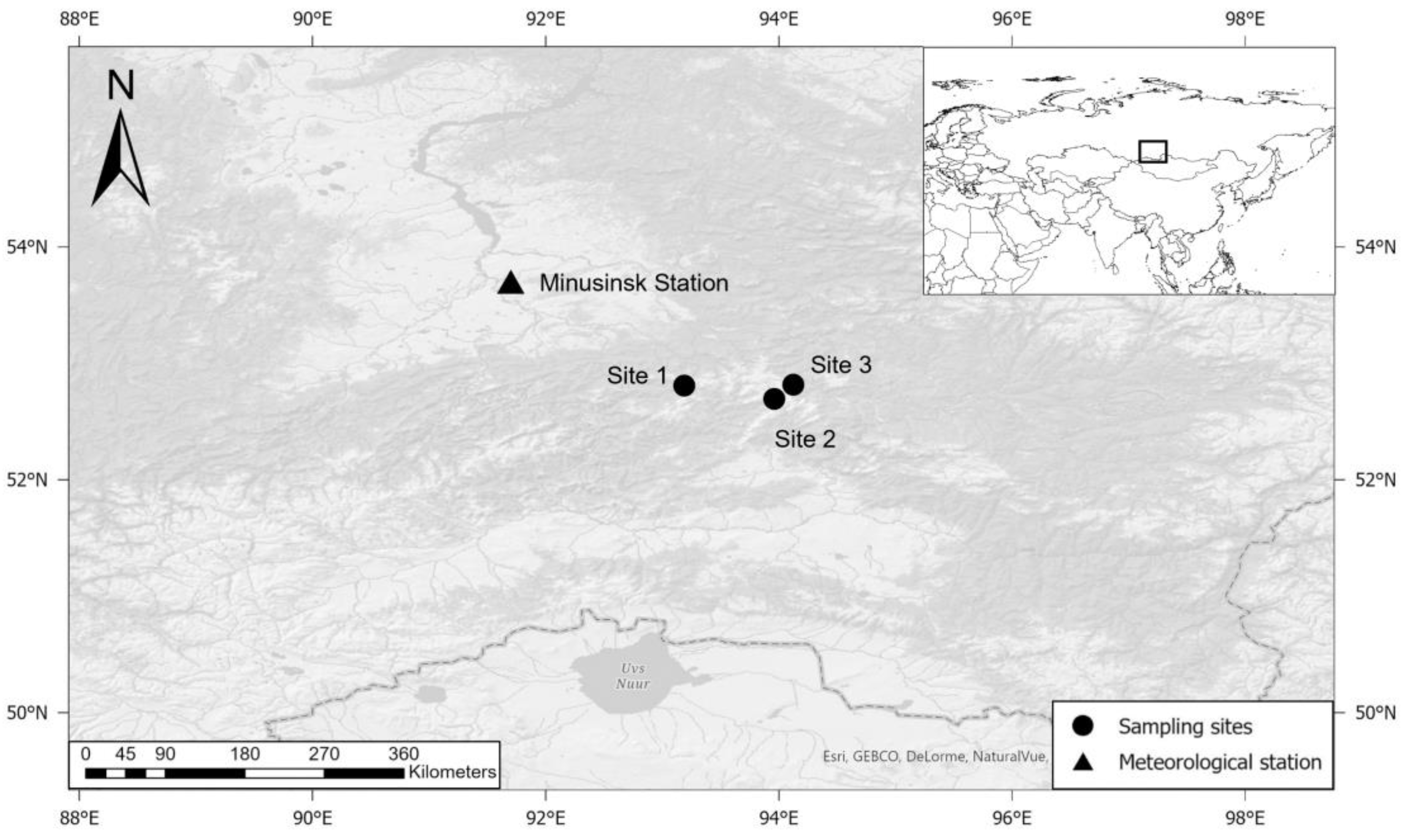
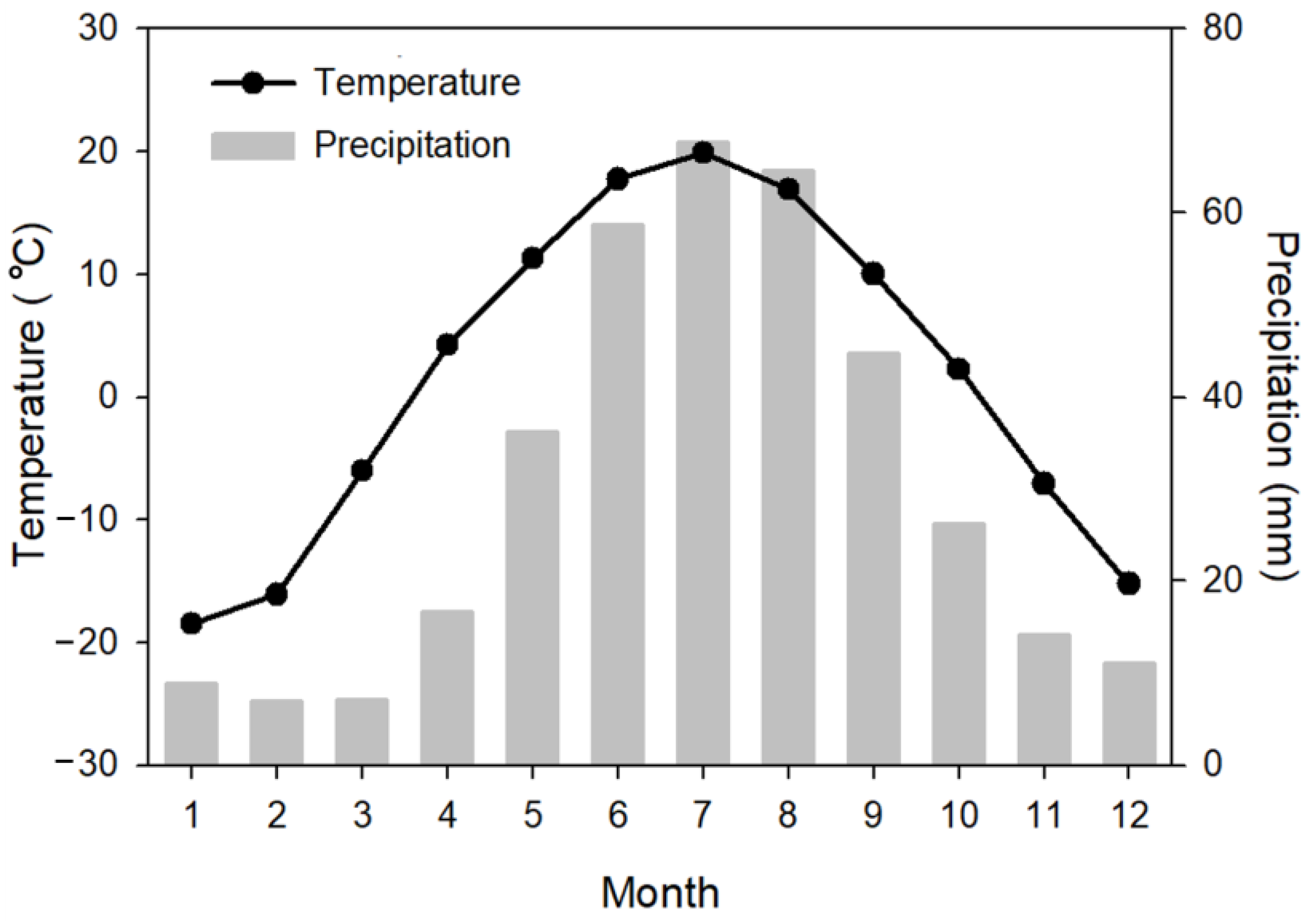
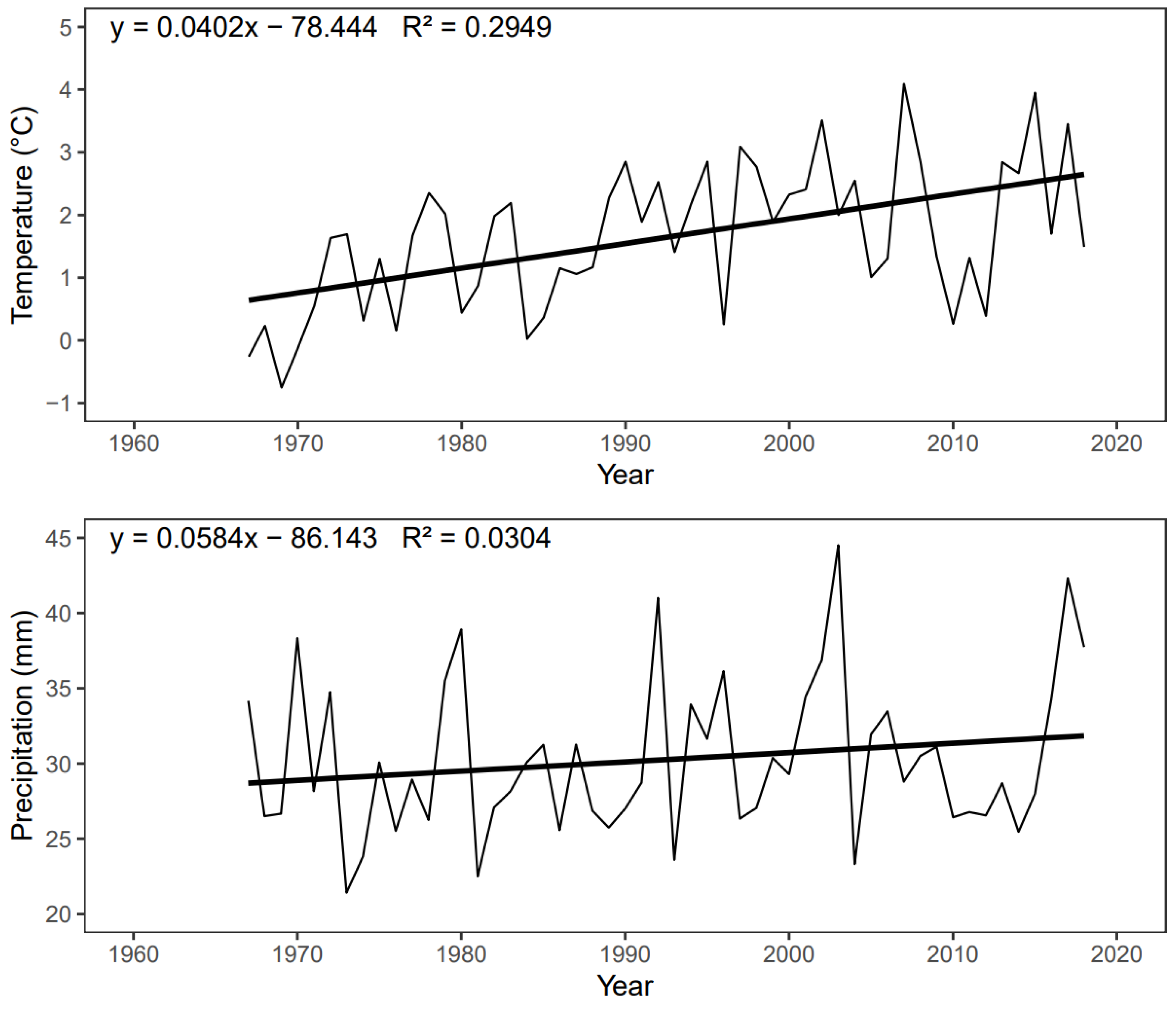
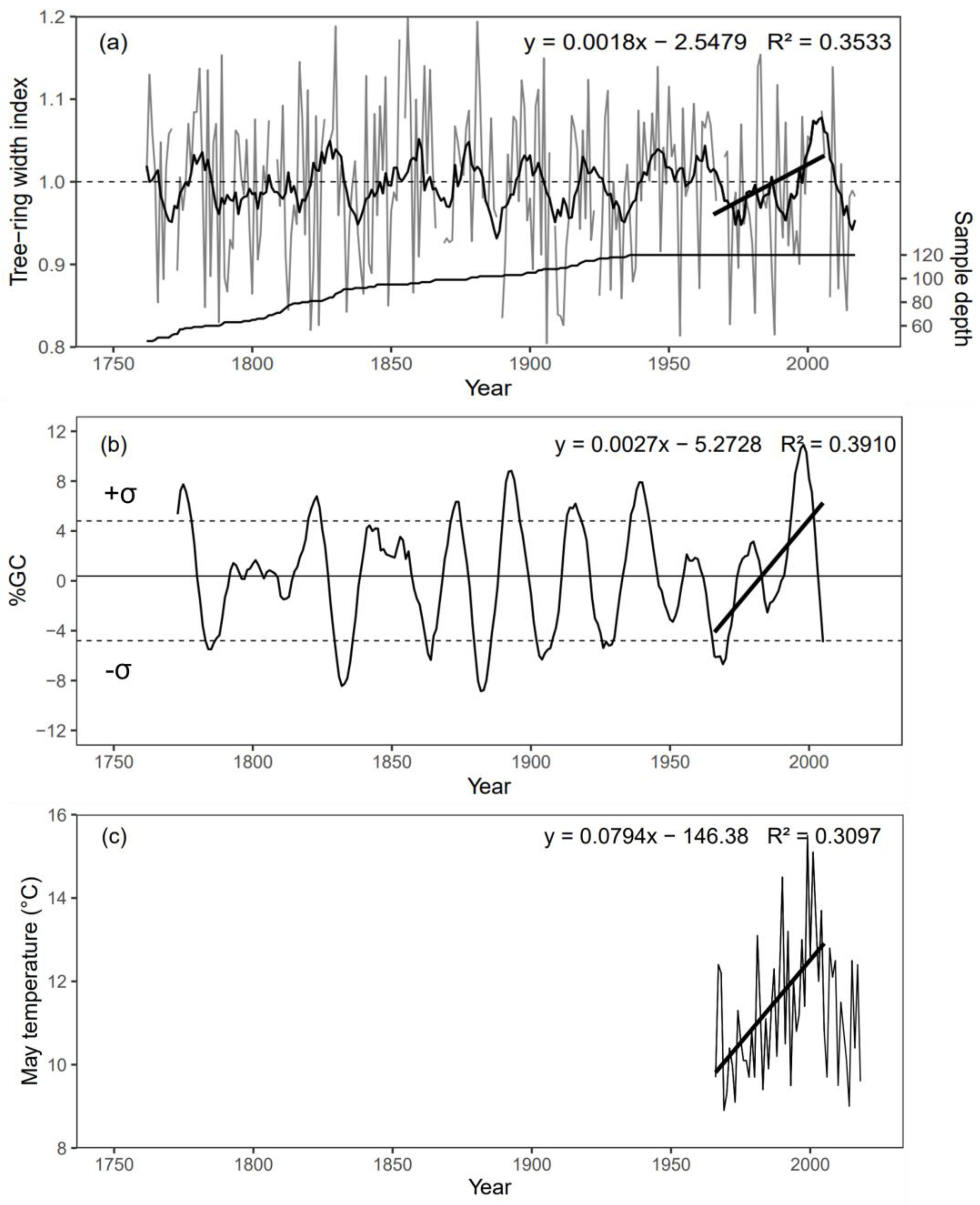
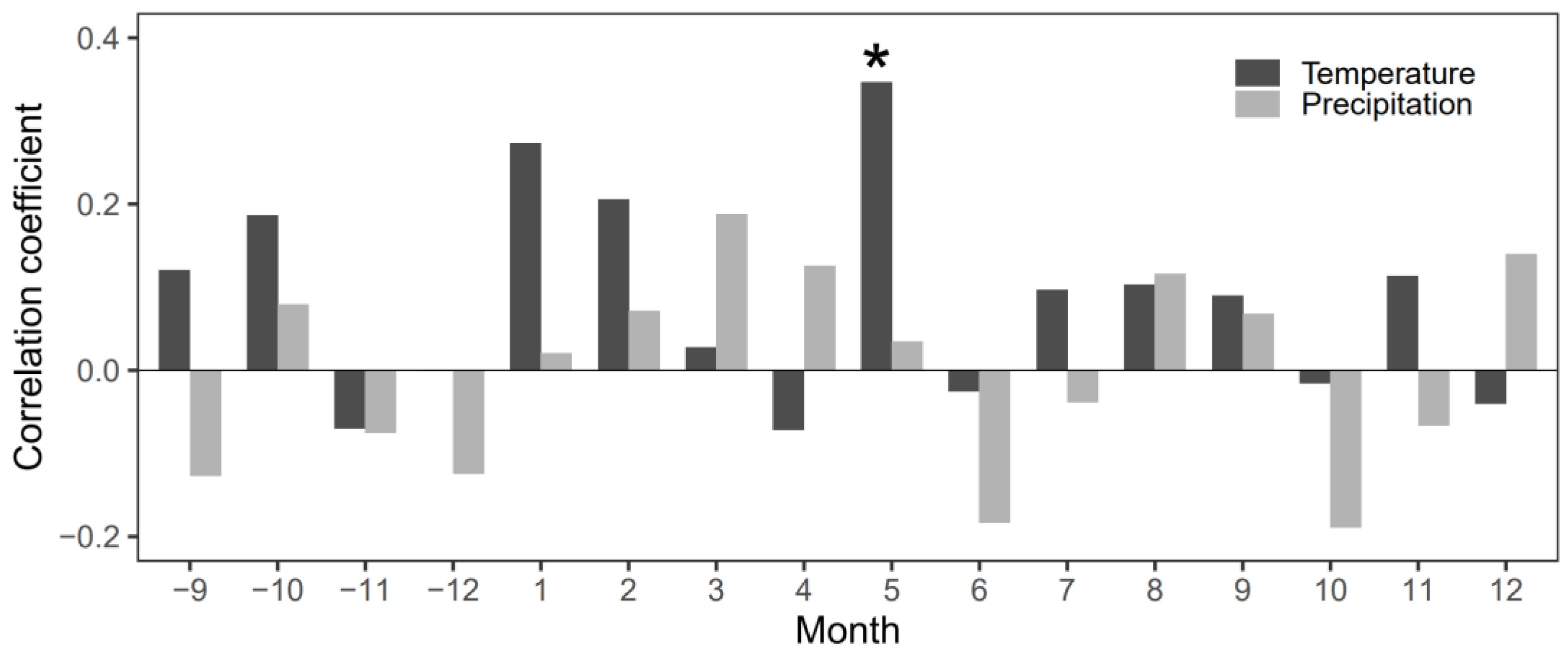


| Site | Latitude | Longitude | Elevation (m a.s.l.) | Cores/Trees | Time Span | Rbar | EPS | SNR |
|---|---|---|---|---|---|---|---|---|
| 1 | 52°48′30.79″ N | 93°11′20.31″ E | 1287 | 40/20 | 1713–2018 | 0.373 | 0.939 | 15.475 |
| 2 | 52°41′38.70″ N | 93°57′32.30″ E | 1265 | 40/20 | 1632–2018 | 0.368 | 0.943 | 16.683 |
| 3 | 52°48′53.51″ N | 94°7′26.46″ E | 1582 | 40/20 | 1581–2018 | 0.423 | 0.939 | 15.477 |
| Positive Growth Rate Anomaly | Negative Growth Rate Anomaly | ||
|---|---|---|---|
| Period | Appearance (Times)/Total Duration (Years) | Period | Appearance (Times)/Total Duration (Years) |
| 1773–1777, 1820–1824, 1872–1874, 1890–1895, 1913–1918, 1936–1942, 1994–2001 | 7/40 | 1784–1786, 1830–1835, 1863–1864, 1880–1885, 1903–1907, 1926–1929, 1966–1970 | 7/33 |
Disclaimer/Publisher’s Note: The statements, opinions and data contained in all publications are solely those of the individual author(s) and contributor(s) and not of MDPI and/or the editor(s). MDPI and/or the editor(s) disclaim responsibility for any injury to people or property resulting from any ideas, methods, instructions or products referred to in the content. |
© 2023 by the authors. Licensee MDPI, Basel, Switzerland. This article is an open access article distributed under the terms and conditions of the Creative Commons Attribution (CC BY) license (https://creativecommons.org/licenses/by/4.0/).
Share and Cite
Yang, F.; Yan, Y.; Liang, H.; Wang, M.; Kang, J.; Jiang, S.; Zhou, P.; Wang, Z.; Shishov, V.V.; Zhang, Y.; et al. Radial Growth Response of Siberian Pines to Climate Warming in the Sayan Mountains, Southern Siberia, Russian Federation. Forests 2023, 14, 463. https://doi.org/10.3390/f14030463
Yang F, Yan Y, Liang H, Wang M, Kang J, Jiang S, Zhou P, Wang Z, Shishov VV, Zhang Y, et al. Radial Growth Response of Siberian Pines to Climate Warming in the Sayan Mountains, Southern Siberia, Russian Federation. Forests. 2023; 14(3):463. https://doi.org/10.3390/f14030463
Chicago/Turabian StyleYang, Feiyu, Yuqi Yan, Hanxue Liang, Minhuang Wang, Jian Kang, Shaowei Jiang, Peng Zhou, Zhou Wang, Vladimir V. Shishov, Yaling Zhang, and et al. 2023. "Radial Growth Response of Siberian Pines to Climate Warming in the Sayan Mountains, Southern Siberia, Russian Federation" Forests 14, no. 3: 463. https://doi.org/10.3390/f14030463
APA StyleYang, F., Yan, Y., Liang, H., Wang, M., Kang, J., Jiang, S., Zhou, P., Wang, Z., Shishov, V. V., Zhang, Y., & Huang, J. (2023). Radial Growth Response of Siberian Pines to Climate Warming in the Sayan Mountains, Southern Siberia, Russian Federation. Forests, 14(3), 463. https://doi.org/10.3390/f14030463








